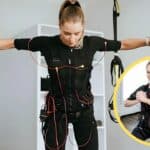Are you tired of the excruciating pain that sometimes accompanies leg day, leaving you feeling sore and defeated? Does the frustration of not seeing the progress you desire in your lower body strength haunt you?
Many fitness enthusiasts face these very challenges, especially when it comes to mastering the ATG split squat. This compound leg exercise can be a real pain point for those seeking to sculpt their lower body. But that’s not all — the agony of improper form and the fear of injury can make leg day a nightmare.
To help, we’ll show you how to do them properly, talk about the potential benefits and give you some tips, so you can see some real gains fast.
Jump to:
How to do ATG split squats?
Let’s dive right into how you can get your ass to the grass with this split squat.
Here’s how to do it:
- Begin standing with your feet shoulder-width apart.
- Take a step back with one foot. This is your starting position before getting into the split squat position. The distance between your feet should be about twice your shoulder width. (This creates the split stance, which is the hallmark of this awesome conditioning exercise.)
- Make sure that your front knee is directly above your ankle and your back knee hovers just above the ground. This is where the “Ass-to-Grass” is going to come into play (your back knee should almost touch the floor with the movement).
- Keep your core muscles tight throughout the movement. This stabilizes your body and helps you maintain balance.
- As you lower your body down, focus on lowering your hips straight down toward the ground. Your weight should be evenly distributed between both legs.
- The goal is to reach the lowest point you can while maintaining proper form. Ideally, your back knee should hover just above the ground, but don’t force it if you’re not there yet. Progress takes time.
- Push through your front heel to return to the starting position. This completes one rep.
Perform the desired number of reps on one side, then switch to the other side. It’s essential to work both legs equally to maintain balance and prevent muscle imbalances.
Remember to breathe throughout the exercise. Inhale as you lower your body and exhale as you push back up.
Pay close attention to your form, especially at the beginning. If you feel any knee pain or discomfort, stop and reassess your technique. Proper form is key to prevent injuries.
What muscles do they work?
The primary muscles ATG split squats targets are the quadriceps, which are on the front of your thighs. These muscles play a crucial role in knee extension and are heavily engaged as you push yourself back up from the squat position.

While the focus is on the quads, your hamstrings also get a good workout with these types of compound exercises. They help stabilize your knee joint (alongside your calf muscle) and assist in the controlled descent.
ATG is one is a great glute development workout. As you push your hips forward to return to the starting position, your gluteus maximus, or gluteal muscles, come into action. They’re responsible for hip extension (along with your hip flexors) and help with the upward movement.
A tight core helps to maintain proper form. Your core muscles, including the rectus abdominis and obliques, work to stabilize your torso and prevent excessive forward or backward leaning.
Adductors and abductors are the inner and outer thigh muscles. They help to keep your legs aligned and provide stability during movement.
Best benefits of this workout routine
Many lower body exercises in the gym focus on isolated muscle groups, but the ATG split squat promotes functional strength. This means the strength you gain is directly applicable to daily activities.
The split stance in this exercise challenges your balance and stability. As you lower yourself into the squat, you’ll feel the muscles around your ankles and knees work hard to keep you steady.
Reaching the “Ass-to-Grass” depth in the squat position requires good hip flexibility—so training the ATG will help with the range of motion of your hip joints.
Tips for progressions, sets, and variants
Next, let’s focus on the different progressions, levels of difficulty, and squat variations that you should strive for with this leg workout. These will help you get the most out of this advanced exercise.
For beginners
As a beginner, your range of motion might not get you all the way to the grass. This is okay and why we are going to help you focus on your hip mobility first before packing on heavy weights. This means doing a slightly easier version that’s going to help develop your hip flexors and all the muscles you’ll need to get to the full ranges of motion.
Initially, practice the ATG split squat using just your body weight to build strength and balance. Pay close attention to your form, especially the alignment of your knees and your core stability. Proper form is the foundation for progression.
Slowly increase the depth or intensity of your squats as you become more comfortable and confident with the movement.
Always warm up your legs and stretch your hip joints before trying split squats to prevent injury.
ATG split squat progression
With the basics mastered, you can progress and challenge yourself with these difficult exercises. Progression is key to continuously improving your lower body strength and flexibility.
- Increase the range of motion: Start by going for a deep split squat. Gradually work on improving your hip flexibility and ankle mobility to sink lower into the squat. A great goal would be to comfortably go full ass to the grass for 4 full sets.
- Add resistance: Once you’re comfortable with bodyweight squats, you can start adding resistance. This can be in the form of a pair of dumbbells held at your sides or a barbell on your shoulders. Adding weight will intensify the workout and further strengthen your leg muscles.
- Single-leg ATG split squat: To challenge your balance and target each leg individually, try the single-leg ATG split squat. Instead of stepping back with one foot, keep one foot off the ground and perform the squat with only one leg. This unilateral movement (single-leg movement) is an amazing movement that lets you really focus on the muscle activation.
- Plyometric ATG split squats: If you’re looking to increase explosive power and agility, consider incorporating plyometric movements. After each squat, explosively jump up and switch legs mid-air to land in the opposite split squat position. Plyometric training can elevate your heart rate and boost your overall athleticism.
- Elevated ATG split squats: Elevating your front foot on a stable surface, like a step or a platform, adds an extra challenge. This variation increases the depth of your squat and engages your leg muscles differently. Be cautious with the height of the elevation to prevent the overextension of your hip flexors.
- Increase the time under tension: Slow down the movement to increase the time you keep your hips under load. Lower yourself into the squat as slowly as possible, hold for a moment at the lowest point, and then push back up.
ATG split squat variants to add to the mix
Variety is the spice of life, and the same holds true for your workout routine. Adding different squat variations can target your muscles in unique ways and prevent boredom.
Here are some ATG split squat variants to spice up your leg day:
- Bulgarian split squat: This variant involves elevating your rear foot behind you on a bench or step while performing the split squat. It places more emphasis on the front leg, particularly the quadriceps, and can help to grow your glutes even more. Top tip – focus on keeping your front foot flat and if you feel it slipping, then you are at your limit.

- Walking ATG split squat: Instead of staying in one spot, take a step forward or backward with each repetition.
- Goblet squat: Hold a dumbbell or kettlebell close to your chest while performing regular split squat. This added weight not only increases the intensity but also encourages an upright posture and works your core.
- Pistol squat: For an advanced challenge, try the pistol squat. It’s a single-leg squat where you extend one leg straight in front of you while keeping the other off the ground. This requires exceptional balance and core strength.
- Paused ATG split squat: Introduce a brief pause at the bottom of the squat to eliminate momentum and maximize muscle engagement. Hold the position for a few seconds before pushing back up.
- Kettlebell swing to ATG split squat: Start with a kettlebell swing, and as the kettlebell reaches its peak, transition into an ATG split squat. This combination move provides a full-body workout.
- Barbell squats: Exactly like a normal squat exercise, except now you hold a barbell over your shoulders while you do the movement. Here you can add weight plates to add a lot of resistance to your leg training routine.
Including these variants in your leg day routine challenges your muscles in different ways. Mix and match these exercises to create a diverse workout that caters to your fitness journey and abilities.
FAQ
What does ATG mean in the ATG split squat?
In the ATG split squat, “ATG” stands for “Ass-to-Grass.” This term describes the depth to which you should lower yourself during the squat. The goal is to get your back knee as close to the ground as possible, almost touching it. This deep range of motion challenges your muscles and increases your hip mobility.
What do split squats target the most?
Split squats primarily target the quadriceps, which are the muscles on the front of your thighs. These muscles play a significant role in extending your knee, and they are heavily engaged as you push yourself back up from the squat position.
Is ATG better than parallel?
Whether ATG or parallel squats are “better” depends on your fitness goals and your body’s capabilities. ATG (Ass-to-Grass) squats involve a deeper range of motion and may be more challenging for some individuals. They can be beneficial for improving hip flexibility and if you want astounding leg development. Parallel squats, where you stop when your thighs are parallel to the ground, are less demanding on hip mobility and may be a better option for those with mobility limitations.
What is the difference between ATG split squat and ATG lunge?
The primary difference between the ATG split squat and the ATG lunge lies in the foot positioning and movement. The ATG lunge involves taking a step forward or backward with one leg and then lowering your body into a lunge position. The focus is on horizontal movement, and the back knee doesn’t necessarily need to touch the ground. It’s more of a lunging motion than a vertical squat.















